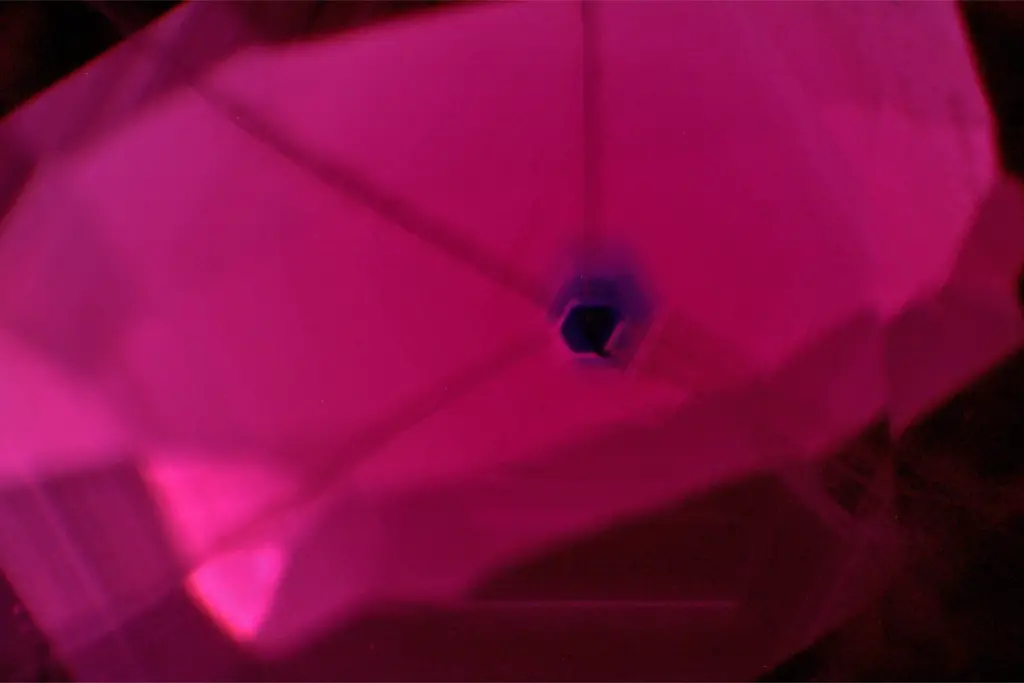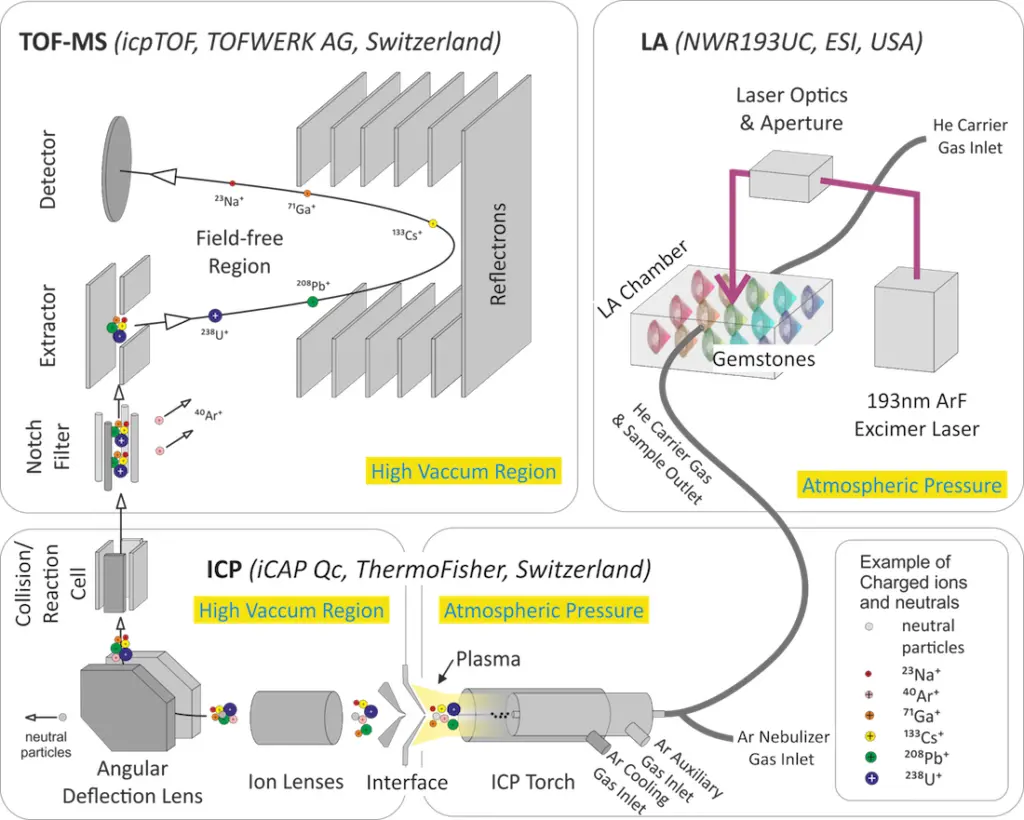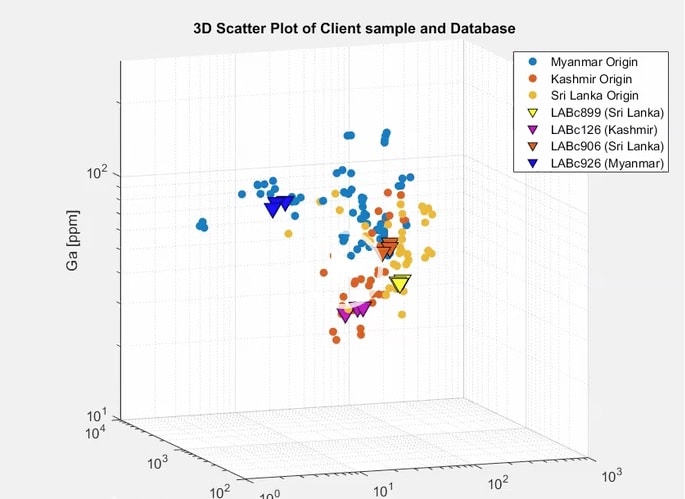GemTOF
GemTOF is a next-generation elemental analytical technique – Laser Ablation Inductively Coupled Plasma Time-Of-Flight Mass Spectrometry (LA-ICP-TOF-MS). GemTOF is able to record nearly all elements in the periodic table simultaneously and at ultra-high speeds and low limits of detection. This breakthrough technique therefore offers new research opportunities in origin determination, age dating, analysis of inclusions and chemical zoning in coloured gemstones, diamonds and pearls.
Quick navigation to:
Applications
GemTOF conducts high quality elemental analyses, produces multidimensional data, and feeds database for statistical analyses. The combination of improved sensitivities and low background noise guarantees a superior limit of detection for heavy elements in parts per billion and for light elements in parts per million. In addition to routine measurements, this new and sophisticated analytical method complements other gemmological testing methods. This enhances trace element characterization of gemstones and pearls for origin determination, treatment detection and isotopic analysis, and opens new research opportunities for origin determination, age dating, inclusion studies or high spatial resolution chemical mapping of gems.
-
Origin Determination
-
Isotopic Analysis
-
U-Pb Dating & Inclusion Analysis
-
Treatment detection
-
Chemical Mapping
GemTOF can measure unique chemical fingerprints consisting of major, minor, trace and even ultra-trace elemental compositions in gemstones due to their various formation conditions and chemical environment. Although it requires a minute ablation volume at the surface (normally on the girdle) of a gem, GemTOF provides valuable chemical data in addition to traditional gemmological analyses. This opens up important opportunities for origin determination of gemstones such as emerald, ruby, sapphire, spinel, alexandrite, garnets and other coloured gems. The acquired chemical information can be displayed in different types of plots in order to categorize gemstones in groups (often gemstone origins).
To illustrate the use of GemTOF, full mass spectra of four sapphires of documented provenance is shown below. The quantitative results of trace elements Magnesium (Mg), Iron (Fe) and Gallium (Ga) are plotted in a three-dimensional scatter plot together with data from a previous study (Halicki, 2013) using LA-ICP-Q-MS on sapphires documented from Kashmir, Sri Lanka and Myanmar of SSEF reference collection with various color saturation. The scatter plot reveals that these reference sapphires from three origins (circles) plot in noticeably separated areas. The four sapphires analyzed by GemTOF (triangles) fit well into the expected plotting areas for the Kashmir, Sri Lanka and Myanmar origins.
Isotopes of one chemical element differ in their masses, but are naturally present in constant ratios of abundance in gemstones. The performance of isotopic analyses using simultaneous acquisition of GemTOF, is expected to be better than that using LA-ICP-Q-MS. The unique natural formation history of gemstones and pearls may lead to slight differences in isotopic ratios in samples. This uniqueness could help to answer questions of carbon source for diamonds or separate synthetic from natural gemstones. Further research is also required with regards to isotopic analysis and origin determination of gemstones such as ruby, sapphire and emeralds.

Gemstones from different origins are likely to have formed at different geological periods. Therefore, age information can be helpful when origin determination of a gemstone is required. Direct age dating of gemstones, such as sapphires, can be difficult. Fortunately, small inclusions such as zircon (often found in sapphire, pointed by white arrow in figure below) can provide useful hints. Zircon is one of the most popular minerals for age dating, as it provides a Uranium (U) - Lead (Pb) age dating system (“geological clock”). In order to precisely measure the U-Pb dating system, multiple isotopes from U and Pb have to be acquired within this small amount of sample (inclusion). Unlike LA-ICP-Q-MS that measures isotopes one after another, which may not be fast enough to acquire enough information for a reliable age dating, GemTOF measures all isotopes simultaneously even in minute zircon inclusions.
Other inclusions (e.g. apatite, calcite, rutile, tourmaline) may provide additional key information about the chemical environment conditions when a gemstone is formed.

GemTOF collects almost all elemental information in the periodic table routinely. When performing a daily measurement, system control computer, displays a first glance of the composition of the gemstone when it is being ablated. Already, abnormal signal intensity can be readily spotted at an earliest stage. It is therefore adapted to detect new and undisclosed chemical treatments in the form of unknown diffusion treatments or coatings. And thus it will help to avoid an unprepared situation such as when beryllium diffusion treated corundum hit the market (and gemmological laboratories) at the turn of the century.

The formation of gemstones is a complex process both in terms of space and time. Chemical (and colour) zoning is common, caused by intrinsic (e.g. oscillatory growth zoning) or extrinsic factors (e.g. change of rock chemistry due to fluid infiltration). A detailed mapping of elemental distribution may provide valuable information about formation kinetics which is not readily perceived based just on few single analysis spots. Preferably in high spatial resolution, the imaging of trace element distribution in a gemstone can thus be a powerful tool. A homogenized 10µm laser spot or even less is needed to provide quantitative element distribution images of high spatial resolution. By controlling the ablation process, it is possible to gain two-dimensional or even three-dimensional elemental distribution.

Frequently Asked Questions
Which client gemstones does SSEF carry out GemTOF testing on?
SSEF since November 2016 is routinely testing submitted coloured gemstones using GemTOF. Please note that SSEF’s Terms & Conditions (on backside of SSEF Order Form and on SSEF website) stipulate that unless explicitly excluded by the client in the order, GemTOF can be carried out on submitted Gemstone(s). Pearls and diamonds are not routinely tested using GemTOF.
Does GemTOF damage my stone?
The minute laser ablation pits produced by GemTOF are hardly visible, and are mostly carried out on the girdle. Furthermore, GemTOF testing does not lead to a weight change in the stone.
What is the difference between Quadropole-MS and TOF-MS?
Unlike the LA-ICP-Quadrupole-MS (LA-ICP-Q-MS) technique already established in the gemmological field, GemTOF is able to record nearly all elements in the periodic table simultaneously and at ultra-high speeds and low limits of detection.
Why does SSEF carry out GemTOF testing?
GemTOF's high precision and low detection limits allow us to gain detailed information on the chemistry of a gemstone. This flows into origin determination research and testing and allows to improve understanding of gemstones from different origins for example.
About
Since early 2000, Laser Ablation Inductively Coupled Plasma Mass Spectrometey (LA-ICP-MS) has proven to be a sensitive and versatile method for trace element analysis of gemstones. LA-ICP-MS allows access to a distinctly wider range of elements than traditional XRF methods, but also to a much better detection limit (especially for light elements such as Lithium, Beryllium, Boron and Sodium), and to different isotopes of the same element. Most of the gemmological studies have been conducted using LA-ICP-Quadrupole-MS setup, which measures isotopes of interest one after another.
Recently, a highly sensitive and novel elemental analytical system, LA-ICP-Time Of Flight-MS, has been introduced into the market. The system allows simultaneous acquisition of the full mass spectrum. In late 2015, SSEF initiated an evaluation project with three leading companies worldwide focusing on implementing such a system at the SSEF laboratory in Basel, Switzerland. The final system was installed in July 2016 at SSEF and is now in operation.

Below shows a sketch of GemTOF setup as in operation at SSEF. A 193nm wavelength laser beam from ArF excimer laser (a) is focused on gemstones (b) sealed in a sample chamber (c). The LA chamber is flushed by helium flow (d) which transports the ablated particles into the ICP torch (e). Plasma (f) dissociates, atomizes and ionizes the particles into preferably singly charged ions (g), which are sampled by interface (h) from atmospheric pressure to high vacuum region. The stream of ions is extracted through a series of ion lenses (i) and neutrals are separated from ions after angular deflection lens (j). Collision/reaction cell (k) can be used to reduce interferences. Entering the TOF-MS, a notch filter (l) first rejects the selected dominant ions (e.g. Ar+) from the ion stream, then the extractor (m) pushes ions orthogonally at a high frequency into the field-free time-of-flight region (n). Ions are mirrored by a reflectron (o) and finally registered at a detector (p).

Full Mass Spectrum Analysis
GemTOF simultaneously acquires the full mass spectrum. As depicted in the figure below, an averaged spectrum shows mass range from 7Li isotope to 238U from ablation signal on NIST610 SRM. Only a few elements (e.g. H, N, O, F, Cl, and noble gases) are not analyzed by GemTOF. They suffer from strong interferences and high backgrounds, or are difficult to be ionized.

Limit of detection
GLimit of detection (LOD) is a figure of merit when describing the detection capability of an analytical instrument, indicating the lowest isotope concentration that is sufficient in order to provide a significant signal above background. As a result of recent instrumental developments, GemTOF benefits from the combination of improved instrument sensitivity and low background noise, which guarantees a superior limit of detection for heavy elements in parts per billion (ppb) and for light elements in parts per million (ppm). In the figure below, typical limits of detection through the full mass range is shown for NIST610 SRM. Laser spot size is 75micrometer and laser repetition rate 20Hz.

GemTOF Publications:
Wang, H.A.O., Krzemnicki, M.S., 2021. Multi-element analysis of minerals using laser ablation inductively coupled plasma time of flight mass spectrometry and geochemical data visualization using t-distributed stochastic neighbor embedding: case study on emeralds. Journal of Analytical Atomic Spectrometry, https://doi.org/10.1039/D0JA00484G
Phyo, M.M., Wang, H.A.O., Guillong, M., Berger, A., Franz, L., Balmer, W.A., Krzemnicki, M.S., 2020. U–Pb Dating of Zircon and Zirconolite Inclusions in Marble-Hosted Gem-Quality Ruby and Spinel from Mogok, Myanmar. Minerals, 10, 195. https://doi.org/10.3390/min10020195
Download Article (PDF)
Wang H.A.O., Krzemnicki M.S., Chalain J-P, Lefèvre P., Zhou W., Cartier L., 2016. Simultaneous High Sensitivity Trace-Element and Isotopic Analysis of Gemstones Using Laser Ablation Inductively Coupled Plasma Time-of-Flight Mass Spectrometry. The Journal of Gemmology, 35(3), 212-223.
Download Article (PDF)
Wang H.A.O., Cartier L.E., Krzemnicki M.S., 2016. GemTOF: A Pioneering Technique in Gemology. Incolor, Fall 2016
Download Article (PDF)
Further Reading:
Abduriyim A., Kitawaki H., 2006. Determination of the origin of blue sapphires using laser ablation inductively coupled plasma mass spectrometry (LA-ICP-MS). Journal of Gemmology, 30(1/2), 23-36.
Burger M., Gundlach-Graham A., Allner S., Schwarz G., Wang H.A.O., Gyr L., Burgener S., Hattendorf B., Grolimund D., Günther D., 2015. High-Speed, high-resolution, multielemental LA-ICP-TOFMS imaging: Part II. Critical evaluation of quantitative three-dimensional imaging of major, minor, and trace elements in geological samples. Analytical Chemistry, 87(16), 8259-8267. DOI: 10.1021/acs.analchem.5b01977
Borovinskaya O., Hattendorf B., Tanner M., Gschwind S., Günther D., 2013. A prototype of a new inductively coupled plasma time-of-flight mass spectrometer providing temporally resolved, multi-element detection of short signals generated by single particles and droplets. Journal of Analytical Atomic Spectrometry, 28, 226-233. DOI: 10.1039/C2JA30227F
Coenraads R.R., Sutherland F.L., Kinny, P.D., 1990. The origin of sapphires: U-Pb dating of zircon inclusions sheds new light. Mineralogical Magazine, 54, 113-122.
Giuliani, G., Chaussidon, M., Schubnel, H.J., Piat, D.H., Rollion-Bard, C., France-Lanord, C., Giard, D., de Narvaez, D., Rondeau, B., 2000. Oxygen Isotopes and Emerald Trade Routes Since Antiquity. Science, 287, 631-633.
Graham I., Sutherland L., Zaw K., Nechaev V., Khanchuk A., 2008. Advances in our understanding of the gem corundum deposits of the West Pacific continental margins intraplate basaltic fields. Ore Geology Reviews, 34, 200–215. DOI:10.1016/j.oregeorev.2008.04.006
Guillong M., Günther D., 2001. Quasi ‘non-destructive’ laser ablation-inductively coupled plasma-mass spectrometry fingerprinting of sapphires. Spectrochimica Acta Part B, Atomic Spectroscopy, 56(7), 1219-1231. DOI: 10.1016/S0584-8547(01)00185-9
Guillong M., Horn I., Günther D., 2003. A comparison of 266 nm, 213 nm and 193 nm produced from a single solid state Nd:YAG laser for laser ablation ICP-MS. Journal of Analytical Atomic Spectrometry, 18, 1224–1230. DOI: 10.1039/B305434A
Halicki P., 2013, Part I: Chemical characterisation of gemquality sapphires from metamorphic and magmatic host rocks: a LA-ICP-MS study. Master thesis, University Basel, Switzerland, 180 pages. Supervised by Dr. Michael S. Krzemnicki.
Krzemnicki M.S, Hänni H.A., Walters R.A., 2004. A new method for detecting Be diffusion-treated sapphires: Laser-induced breakdown spectroscopy (LIBS). Gems & Gemology, 40(4), 314-322.
Link K., 2015. Age determination of zircon inclusions in faceted sapphires. Journal of Gemmology, 34(8), 692-700.
Longerich L.P., Jackson S.E., Günther D., 1996. Laser Ablation Inductively Coupled Plasma Mass Spectrometric Transient Signal Data Acquisition and Analyte Concentration Calculation. Journal of Analytical Atomic Spectrometry, 11, 899-904.
Pay D., Shigley J., Padua P., 2014. Carbon Isotope Studies Reveal Diamond Growth History. http://www.gia.edu/gia-news-research-carnegie-carbon-isotope-studies-diamond retrieved on 26. Aug. 2016.
Pettke T., Oberli F., Audétat A., Guillong M., Simon A.C., Hanley J.J., Klemm L.M., 2012. Recent developments in element concentration and isotope ratio analysis of individual fluid inclusions by laser ablation single and multiple collector ICP-MS. Ore Geology Reviews, 44, 10–38.
Rankin A.H., Greenwood J., Hargreaves D., 2003. Chemical fingerprinting of some East African gem rubies by laser ablation ICP-MS. Journal of Gemmology, 28(8), 473-482.
Sutherland F.L., Bosshart G., Fanning C.M., Hoskin P.W.O., Coenraads R.R., 2002. Sapphire crystallization, age and origin, Ban Huai Sai, Laos: age based on zircon inclusions. Journal of Asian Earth Sciences, 20, 841-849.
Sutherland F.L., Duroc-Danner J.M., Meffre S., 2008. Age and origin of gem corundum and zircon megacrysts from the Mercaderes-Rio Mayo area, South-west Colombia, South America. Ore Geology Reviews, 24, 155-168.
DOI:10.1016/j.oregeorev.2008.01.004
Sutherland F.L., Zaw K., Meffre S., Giuliani G., Fallick A.E., Graham I.T., Webb G.B., 2009. Gem-corundum megacrysts from east Australian basalt fields: trace elements, oxygen isotopes and origins. Australian Journal of Earth Sciences, 56, 1003–1022.
DOI: 10.1080/08120090903112109
